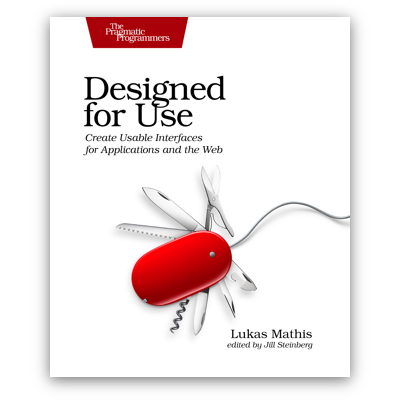I've Written a Book
Executive summary: I've written a book. If you like this site, you'll love the book. You can buy it printed on paper or as a DRM-free ebook on the Pragmatic Programmers website.
I'm often approached by programmers, visual designers, and sometimes even by project managers who want to learn more about usability. The conversation typically goes something like this:
"I want to learn about usability, but I don't really know where to start. Are there any good books you can recommend?"
Of course, there are, I answer. You should probably buy both of Steve Krug's books. Start with Don't make me think, and then read Rocket Surgery Made Easy. This will give you an overview of what usability is, and how to do usability tests. Next, you should read Carolyn Snyder's book on paper prototyping, because that's a really important aspect of usability testing. Oh, I forgot, you definitely want to read Don Norman's The Design of Everyday Things before you read any of the other books, and probably also Emotional Design. Wait, are you doing web design? In that case, also read Jakob Nielsen's Designing Web Usability. I also like his Homepage Usability, there's lots of great stuff in there. If you're a programmer, read Joel Spolsky's User Interface Design For Programmers. Oh, also, it's probably a good idea to know some basic stuff about psychology, so...
At this point, they usually stop me. "Do I have to read all of these books? I don't need to know everything. I just want to, you know... Isn't there a single book I can read that teaches me the ten percent of this stuff that I'm actually going to use?"
There wasn't, so when The Pragmatic Programmers asked me if I wanted to write a book for them, I decided that this would be the book I'd write. After more than a year of writing, tech reviews, rewriting, more tech reviews, and more rewriting, it's finally done.1
The book is called Designed for Use: Create Usable Interfaces for Applications and the Web.
The book follows a typical design process. I've divided it into three parts: Research, Design, and Implementation. In each part, I introduce some of the most important techniques you'll use (techniques like Job Shadowing, Contextual Interviews, Card Sorting, Cloze Tests, Paper Prototype Testing, Usability Testing, or A/B Testing), and relevant concepts that will help you come up with usable designs (for example, I'll explain how to make text usable, how to deal with hierarchies, when and how to use realistic graphics, when to use animations, what modes are, when to avoid them and when to use them, and what we can learn from video games).2
While the book is aimed at people who are new to usability, I believe it's useful even if you have some (or a lot of) experience in the field, as evidenced by positive feedback I've received from other designers. Here are some testimonials:
Keith Lang, COO and interaction designer, Skitch:
An encyclopedic narrative of the life cycle of software UX design, stuffed with best practices, timely examples, and solid design methodologies. I wish I had it years ago!
Jon Bell, interaction designer, Windows Phone:
It’s hard to write about usability concepts without sounding overly academic, but that’s exactly what Lukas has done. This book is a must-read if you are familiar with basic usability concepts and are ready to learn more.
Paul Neave, interaction designer, Neave Interactive:
"Designed for Use" distills Lukas’s brilliant insight into the much neglected area of usability, UX, and UI design. An essential, authoritative, and enlightening read.
If you like the things I write on this site, you should love this book, because it's a lot more of my writing, it's been reviewed by some of the best designers in the field,3 and it's professionally edited (unlike this site). So feel free to go buy a printed copy or a DRM-free ebook directly on the pragprog.com site, and if you want to do me a solid, please write a review on Amazon.4
More
- There's a promo movie for the book.
- I've written a FAQ that answers some questions I've heard.
- Jon Bell has kindly written a review of the book.
-
By "done", I mean that my publisher told me that I would have to stop writing, because they were going to send it to the proofreading and layout departments. I don't think it would ever have been done otherwise. ↩︎
-
You can read the full table of contents (PDF) online. ↩︎
-
As well as by programmers, a project manager, a poet who made sure that my writing was acceptable to her critical eye, and two psychology students who helped me research the book's sections that talk about human behavior and psychology. ↩︎
-
You know how, when you browse books on Amazon, you decide which ones to buy based on customer reviews? Other people do that too. A lot of other people. So writing a review really is a huge help. ↩︎
If you require a short url to link to this article, please use http://ignco.de/384





